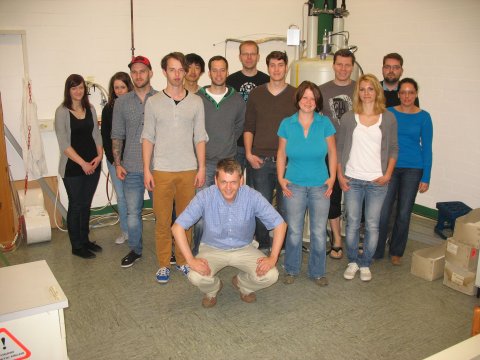Report of the 12. DMG Shortcourse "Applications of Solid State NMR Spectroscopy in the mineralogical and geoscientific research "
in Bochum from 29. May – 01. June 2012

As it is almost tradition the DMG/DGK short course on NMR spectroscopy took place at the University of Bochum from May 29th till 1st of June. Under the supervision of Dr. Michael Fechtelkord 14 participants from several universities in Germany but also from Austria and Switzerland dedicated four days to explore the possibilities of NMR spectroscopy.
After a theoretical introduction in the morning the newly leaned knowledge was carried into the lab to test it in the real world. Thus the Tuesday afternoon was devoted to the first trials on measuring the spin-relaxation of 1H and the dynamics of tetramethylammoniumiodide. Doing so the participants gained a first impression on how to handle a spectrometer and how to prepare the samples for this kind of measurements. But no analysis procedure is complied without the actual evaluation of the measured data.
Thus after this first day of getting to know the huge magnet better (see picture) the next day started with the theory of dipole and chemical interactions in solids. The aim was to find a solution to the problem of how to measure a good spectrum despite the presence of anisotropy effects. The answer is simple and fascinating at the same time, by using the magic angle. But still, having solved this problem, the evaluation of the spectra need a lot of experience and patience.
On Thursday the participants took a peek into the rabbit hole. NMR spectroscopy can not only show the local distortions in the crystal lattice induced by doping but it can also distinguish between different atomic neighbors.
It is quite fascinating to see which possibilities arise from the NMR spectroscopy to find answers for many scientific problems. Also it is amazing to see how scientists came up with new solutions for experimental problems to measure what could not be measured before.
Last but not least this short course gave young scientists the opportunity to exchange experiences in a relaxed atmosphere. Two social events had been organized to great success.
Naemi Waeselmann,
Hamburg


